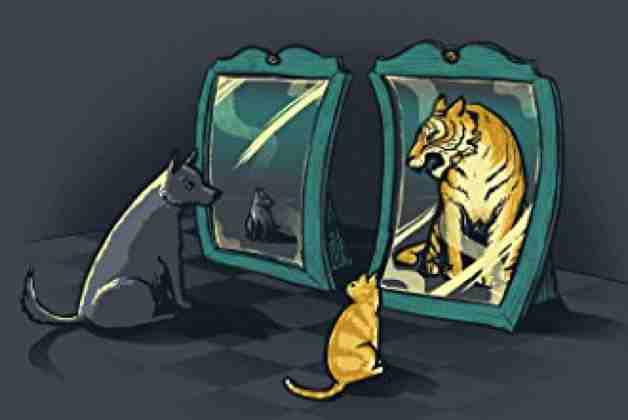When I was read the book Good to Great by Jim Collins, he referred to a leadership concept that he called “The Window and the Mirror”. At the time I really did not pay much attention to the concept but in the following days and weeks, I began to see the essence of this phenomenon for myself in many of the people that I met. The insight gave me the opportunity to see many people in a completely new light.
So, what is “The Window and the Mirror” concept? The window is a metaphor for looking at external conditions while the mirror is a metaphor for self-reflection.
When a less effective leader encounters an obstacle, they look out the window and try to find external conditions to blame. When something good happens, they look into the mirror and take the credit personally for the situation.
However effective leaders use the window and mirror in very different ways. When an effective leader encounters a problem, they look into the mirror and ask what could I have done differently and take ownership of the problem. When something good happens, they look out the window and say that it was external events or their team that helped achieve the positive results.
During further research on Jim’s “The Window and the Mirror” concept after having written about his Hedgehog and Flywheel concepts, I discovered the following article by Aidan McMullen who did an excellent job at describing the concept of the window and the mirror leadership concept. I hope you enjoy it as much as I did.
“If you fail to honor your people, They will fail to honor you; It is said of a good leader that When the work is done, the aim fulfilled, The people will say, “We did this ourselves.”
Lao Tzu, 604–531 B. C.
The Window and The Mirror
Paolo Coelho tells us the following story:
A very rich young man went to see a Rabbi in order to ask his advice about what he should do with his life. The Rabbi led him over to the window and asked him:
“What can you see through the glass?”
“I can see men coming and going and a blind man begging for alms in the street.”
Then the Rabbi showed him a large mirror and said to him:
“Look in this mirror and tell me what you see.”
“I can see myself.”
“And you can’t see the others. Notice that the window and the mirror are both made of the same basic material, glass. You should compare yourself to these two kinds of glass. Poor, you saw other people and felt compassion for them. Rich — covered in silver — you see yourself.”
“You will only be worth anything when you have the courage to tear away the coating of silver covering your eyes in order to be able to see again and love your fellow man.”
Leadership, Windows and Mirrors

In Good to Great, author Jim Collins talks of level 5 (exceptional) leadership and a phenomenon he calls “The Window and the Mirror”. This is a trait Collins and his team observed in every top-performing company leader in their landmark study.
The essence of the Window and the Mirror leader is crediting others for the company’s success and blaming themselves for the company’s failings. Such leaders believe if mistakes happened on their watch, it is their fault. Let’s call these Window-first leaders.
Author of ‘Mindset’ Carol Dweck talks about Growth Mindset leaders versus Fixed Mindset leaders. She tells us that narcissistic CEOs have a fixed mindset. Such CEOs want to be the smartest person in the room and ensure they receive credit for all the wins in a company. When things go wrong they look out the window at their people and point the finger. When things go right, they look in the mirror at themselves and point the finger and ensure all the credit goes to them.
Mirror-first leaders do not develop others because they see it as a loss of their power. A fixed mindset is much like a scarcity mindset. They do not credit others because they see this as less available credit for themselves. (They are like the Black Walnut we discussed on a previous Thursday Thought).
Dweck cites the comparison of Lee Iacocca (Chrysler CEO) and Jack Welch (General Electric CEO).
When Iacocca took over Chrysler he initiated a great turnaround of the failing company. He was adorned in the press and he soaked up all the praise. However, due to a fixed mindset and mirror-first mentality, he fired those who questioned his ideas, he stopped growing, and soon the company suffered drastic consequences.
In the eighties, General Electric suffered an insider trading crisis with Kidder, Peabody (an investment bank GE had acquired) and on another occasion, a trader made some fictitious trades to boost his bonus. Jack Welch was the presiding CEO. Welch looked in the mirror. He rang 14 senior GE executives to personally apologize. Welch said of the scandal: “I blamed myself for the disaster”.
Great leaders take accountability for failures as well as successes.
Great leaders are not afraid to be human.
Great leaders are strong enough to be vulnerable.
However, to be great, they must have board support and be in a psychologically safe environment.
Pointing the Finger

Soon after my son Jake was one, he developed a terrible skin rash. We brought him to the best skin specialists. The medications did not work. “Why can no doctor solve this?” we agonized.
One evening, when I came home from work and kissed him, I noticed my lip marks on his cheek as if I was wearing lipstick. I quipped to my wife “He must be allergic to me”, “He gets that from his mother”, she retorted (disturbingly quickly I might add).
At the time, I was on a paleo diet and eating raw nuts every day.
Sometimes WE are the Problem
Soon afterwards, we discovered my son had a high-grade nut allergy and that I was indeed the problem.
It reminded me what my mother used to tell me:
“When you point one finger, there are three fingers pointing back to you.”
As a leader at any level of life, we must be aware of this. Organizations amidst a sea of disruption in today’s business environment. Many leaders choose short-term initiatives to boost (short-term) profits to make the company thrive under their tenure. They do not invest in the future of the company, they do not foster a growth mindset in the company and they do not work for long-term improvement.
When the company falters, they point to market conditions, market disruptors, when they point, they ignore the three fingers pointing back. They fail to point in the mirror.
Mirror Neurons, Leader Shadows, Leader Mirrors

Mirror Neurons are neurons that fire both when we act and when we observe the same action performed by someone else. This is most apparent when it is an act we are familiar with performing ourselves. For example, if I was to randomly wave my arms in front of you it would not fire your mirror neurons. However, if I were to smile at you (especially if you know me) your mirror neurons would trigger you to smile. This is why when public speakers ask for a show of hands, they put up their own hand up because it triggers our mirror neurons.
Think of an advertisement where someone is drinking a delicious, ice-cold mouth-watering drink in an ice-cold, frosted glass. See how it makes you feel. Most likely, mimicking the drinking action, you can almost taste the mouth-watering drink in your mouth.
Mirror Neurons are essential for learning by mimicking. They are also vital for empathy, they help us understand others.
Shadow of the Leader is a phrase used to describe a business phenomenon where people in a position of authority, through organizational habits, beliefs and values can influence the culture of those around them. (This influence can be good or bad).
In order to get ahead in an organization, in order to fit in, employees take cues from their leader.
“Every great institution is the lengthened shadow of a single (wo)man. His (Her) character determines the character of the organisation.” — Ralph Waldo Emerson
Mirror Leadership
Mirror of the Leader is an extension of the shadow of the leader. concept. The shadow concept suggests a leader’s shadow reaches deep into a company, it refers to the end result of leadership (good or bad).
Mirror Leadership refers to an ever-evolving leadership practice. It proposes a self-aware leader, a rounded leader equally charged with soft and hard skills and knowing which to use and when to use them. Such a leader understands the concept of mirror neurons. Mirror Leaders understand the actions and intentions of others. This enables them to practice empathy and emotional intelligence.
By understanding the motivations and desires of their people, they win the workplace. By understanding the motivations and desires of their customers, they win the marketplace.
In the world of sport, we talk about leading from the front and leading by example.
Mirror Leaders understand that their influence is reflective and they must reflect the right culture.
The right culture then leads the people.
“Effective leaders don’t say ‘I.’ They don’t think ‘I.’ They think ‘we’; they think ‘team.’ They understand their job to be to make the team function. They accept responsibility, but ‘we’ gets the credit. This is what creates trust, what enables you to get the task done.”
Peter F. Drucker
Aidan McCullen describes himself as a transformation consultant in innovation, leadership, neuroscience, cognitive bias, culture, and digital. He is also a keynote speaker, innovation show host, and retired rugby player. He is a principal at Edge Behaviour and the host of “The Innovation Show” and the author of the book “Undisruptable” This article originally appeared on Medium and is reproduced here with the author’s permission.












